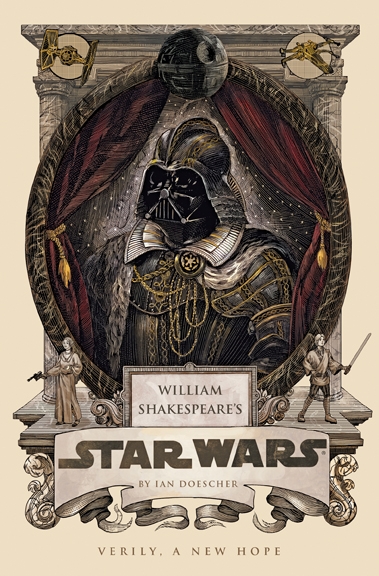 It’s finally happened: Ian Doescher has blessed the world with the nerdiest book possible, William Shakespeare’s Star Wars.
It’s finally happened: Ian Doescher has blessed the world with the nerdiest book possible, William Shakespeare’s Star Wars.
Shakespeare has often been seen as boring and impossible to understand, but that stigma is no more. Now people other than theatre majors (like me) and great academics can enjoy the style of the Bard while celebrating one of the greatest galactic stories ever told.
This play has everything you love about Star Wars, including its characters, as well as a comprehensible look at the work of one of the world’s most famous writers, Shakespeare. In a time where our lives seem to be concocting a technologically influenced type of literacy, it is nice to see that someone still remembers the literary genius of centuries ago.
The concept seems basic: the book presents the story of Star Wars: A New Hope written as a Shakespearean play. The characters, conflict and setting are all the same, except the characters speak in Modern English. Since it is required that everyone watch Star Wars at least once in their life, the story is familiar so readers won’t be caught up in Doescher’s translation. With the adaptation of the story, there are plenty of doth’s and thy’s to go around to please the fans of the Bard’s work and keep the style true to its 16th Century roots.
Translating into Shakespearean Modern English, however, meant more than swapping every “has” for “hath” and every “you” for “thou.” It required that the book to be written completely in iambic pentameter (a metrical line system used to measure out the rhythm of the text). This system is used to show which syllables are stressed and unstressed and how many syllables make up each line. It is a very complicated system used in all of Shakespeare’s poems and plays, so Doeschner’s accurate use of this method is quite a feat. And trust me, I counted to make sure it was right! Even the speech of characters like R2-D2, who talks completely in “beep”s and “boop”s, is factored into the verse. In true Shakespearean style, Doescher includes soliloquies for R2-D2 so that the droid can share his inner thoughts with the audience, unheard by the other characters in the play.
As a fan of both Star Wars and theatre I was extremely impressed by the accuracy of Doescher’s format and style as well as the truth in his adaptation of the storyline. George Lucas’ original story has not lost any amount of suspense, originality or sheer nostalgia as a result of the translation.
Find a small sample of the book below so you can experience the brilliance of the masterpiece:
Another facet that makes William Shakespeare’s Star Wars a must-buy is its illustrations. Shakespeare was meant to be seen, not read, but Doescher’s play would cost a few million dollars to produce for a public audience. To make up for the lack of visuals of the written word, Doescher was kind enough to include his drawings in the story. My favorites include the Cantina Band in period costumes playing the appropriate medieval instruments and Luke speaking to a deceased Stormtrooper’s helmet a la Hamlet (seen in the excerpt above).
For more information on the book and where you can find it for your own, visit Quirk Books.
Do you think William Shakespeare’s Star Wars is worth the read? Comment below and let us know how you feel about this literary mashup!


